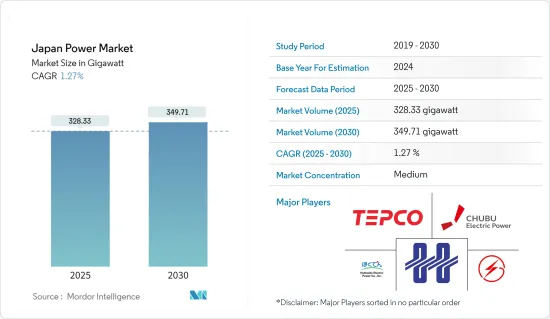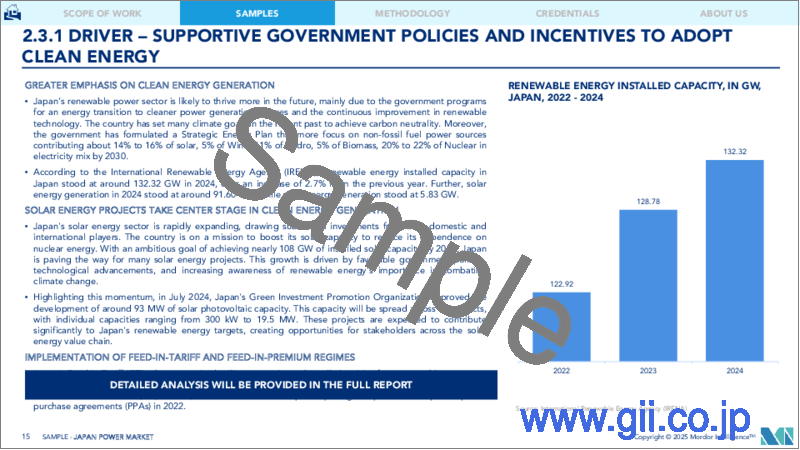|
|
市場調査レポート
商品コード
1690902
日本の電力- 市場シェア分析、産業動向・統計、成長予測(2025年~2030年)Japan Power - Market Share Analysis, Industry Trends & Statistics, Growth Forecasts (2025 - 2030) |
||||||
カスタマイズ可能
適宜更新あり
|
|||||||
| 日本の電力- 市場シェア分析、産業動向・統計、成長予測(2025年~2030年) |
|
出版日: 2025年03月18日
発行: Mordor Intelligence
ページ情報: 英文 90 Pages
納期: 2~3営業日
|
全表示
- 概要
- 目次
概要
日本の電力市場規模は2025年に328.33ギガワットと推定され、予測期間(2025~2030年)のCAGRは1.27%で、2030年には349.71ギガワットに達すると予測されます。

主要ハイライト
- 中期的には、太陽光発電システムの価格と設置コストの低下、再生可能エネルギー技術の進歩、政府の支援策が日本の電力市場を牽引すると予想されます。
- LNGコストの変動と輸入依存度の高さは天然ガス発電に影響を与え、予測期間中の市場成長の妨げになると予想されます。
- 日本の洋上風力発電セグメントの進展は、将来、日本の電力市場にいくつかの機会を生み出すと考えられます。
日本の電力市場の動向
火力発電が市場を独占する展望
- 2023年時点で、火力発電所は日本の総設備容量の46.96%近くを占め、日本の電源構成に最も貢献しています。Organization of Cross-Regional Coordination of Transmission Operators(OCCTO)によると、2023年、日本の火力発電設備容量は481カ所以上、1,506万kW近くになります。
- 経済産業省のデータによると、日本には火力発電資産を保有する発電事業者が214社近くあります。しかし、日本の火力発電市場は旧一般電気事業者に支配されており、火力発電設備容量の合計が3GWを超える企業は、北海道電力、東北電力、JERA、北陸電力、関西電力などの大手企業を含めても10社に過ぎないです。
- 日本の火力発電部門はLNG火力発電所によって占められており、総発電容量の53.1%近くを占めています。経済産業省の統計によると、日本には69の発電所があり、平均設備容量は110万kWです。次いで石炭火力発電所が95基近くあり、総設備容量の32.2%を占めています。
- しかし、ロシアとウクライナの紛争が始まって以来、日本のLNG供給状況はますます悪化しています。例えば、2023年には600万トン/年(MTPA)近くの長期LNG供給契約が満了し、日本の契約上のLNG供給量は8%近く減少すると予想されていました。
- 日本企業は2023年と2024年に、この動向を逆転させるために主要LNG供給国と新たな契約を交渉しました。例えば、2024年5月、オーストラリアの石油・ガス会社であるサントスは、日本の北海道ガスと液化天然ガス(LNG)の長期供給・購入契約(SPA)を結びました。この契約により、北海道ガスは10年間で年間最大40万トンのLNGを供給することになります。
- したがって、上記の要因により、予測期間中、火力発電が電力市場の最大セグメントとなる見込みです。
再生可能エネルギー技術の進展と政府の支援策
- 日本の再生可能エネルギー電力部門は、よりクリーンなエネルギー源への移行を目指す政府の強力なイニシアティブと、再生可能エネルギー技術の継続的な進歩に牽引され、大きく成長する態勢にあります。日本は野心的な気候変動目標を設定し、カーボンニュートラルを目指しています。
- 日本の第6次エネルギー戦略計画では、エネルギーミックスに占める再生可能エネルギーの割合を、2030年までに36%から38%に引き上げることを目標としています。脱原発にともない、日本は太陽光、風力、潮力などの自然エネルギーの採用を増やしており、外国エネルギーへの依存を減らし、国内のエネルギー革新を促進することを目指しています。
- さらに、日本の経済産業省による「グリーン成長戦略」は、2050年までにカーボンニュートラルを目指しています。この戦略では、自然エネルギーの野心的な推進、原子力の復活、低炭素水素、先進原子炉、カーボンリサイクルなどの最先端技術の採用が概説されています。これらの開発は、再生可能技術の進歩を促進する態勢を整えています。
- 経済産業省資源エネルギー庁の発表によれば、2023年9月現在、日本の再生可能エネルギー発電所は約4,730カ所で、前年比で年間458カ所増加しています。政府の支援的な戦略や施策により、再生可能エネルギープロジェクトに対する今後の投資が急増する中、再生可能エネルギー発電所の数は予測期間中に増加すると予想されます。
- 例えば、2024年5月、アブダビを拠点とする政府系投資家Mubadala Investment Company(Mubadala)は、PAGのアジア太平洋再生可能エネルギープラットフォームに投資しました。このプラットフォームは、日本の企業に太陽光発電ソリューションを提供することを戦略的中心としています。
- 施策、制度、野心的な再生可能エネルギー目標など、このような政府の強力な後押しがあることから、日本の再生可能エネルギー市場は今後数年で成長する態勢が整っています。
日本の電力産業概要
日本の電力市場は適度にセグメント化されています。同市場の主要企業には、Tokyo Electric Power Company、Tohoku Electric Power Company、Hokkaido Electric Power Company、Chubu Electric Power Company、Hokuriku Electric Power Companyがあります。
その他の特典
- エクセル形式の市場予測(ME)シート
- 3ヶ月間のアナリストサポート
目次
第1章 イントロダクション
- 調査範囲
- 市場の定義
- 調査の前提
第2章 エグゼクティブサマリー
第3章 調査手法
第4章 市場概要
- イントロダクション
- 2029年までの日本の発電設備容量と予測
- 日本の発電量と予測(2029年まで)
- 再生可能エネルギーミックス:日本、2023年
- 最近の動向と開発
- 政府の規制と施策
- 市場力学
- 促進要因
- 太陽光発電システムの価格と設置コストの低下
- 再生可能エネルギー技術の進歩と政府の支援策
- 抑制要因
- LNGコストの変動と輸入依存度の高さが天然ガス発電に影響
- 促進要因
- サプライチェーン分析
- PESTLE分析
第5章 市場セグメンテーション
- 発電源
- 火力
- 水力発電
- 原子力
- 再生可能エネルギー
- 送配電(T&D)
第6章 競合情勢
- M&A、合弁事業、提携、協定
- 主要企業の戦略
- 企業プロファイル
- Hokkaido Electric Power Company
- Tohoku Electric Power Company
- Tokyo Electric Power Company
- Chubu Electric Power Company
- Hokuriku Electric Power Company
- Kansai Electric Power Company
- Chugoku Electric Power Company
- Shikoku Electric Power Company
- Kyushu Electric Power Company
- Okinawa Electric Power Company
- 市場ランキング/シェア(%)分析
第7章 市場機会と今後の動向
- 日本の洋上風力発電セグメントの進展
目次
Product Code: 72379
The Japan Power Market size is estimated at 328.33 gigawatt in 2025, and is expected to reach 349.71 gigawatt by 2030, at a CAGR of 1.27% during the forecast period (2025-2030).

Key Highlights
- In the medium period, the declining price and installation cost of solar PV systems, advancements in renewable energy technologies, and supportive government initiatives are expected to drive the Japanese power market.
- Volatility in LNG costs and high reliance on imports impact natural gas power generation and are expected to hinder the market's growth during the forecast period.
- Nevertheless, the progress in the Japanese offshore wind power sector is likely to create several opportunities for the Japanese power market in the future.
Japan Power Market Trends
Thermal Power Generating Source is Expected to Dominate the Market
- As of 2023, the thermal power plant sector was the largest contributor to Japan's power mix, accounting for nearly 46.96% of the country's total installed capacity. In 2023, according to the Organization of Cross-Regional Coordination of Transmission Operators (OCCTO), the country had nearly 150.06 GW of installed thermal capacity from more than 481 power plants.
- According to Ministry of Economy, Trade, and Industry (METI) data, Japan has nearly 214 electricity generation companies that own thermal electricity generation assets. However, the Japanese thermal power market is dominated by former general electric utilities, with only ten companies having a total installed thermal capacity exceeding 3 GW, which include major companies such as Hokkaido Electric Power Co., Tohoku Electric Power Co., JERA, Hokuriku Electric Power Co., and Kansai Electric Power Co.
- The Japanese thermal power sector is dominated by LNG-fired plants, which account for nearly 53.1% of the total power capacity. According to METI statistics, Japan has 69 plants, with an average installed capacity of 1.1 GW. This is followed by coal-fired power plants, which account for nearly 95 plants and 32.2% of the total installed capacity.
- However, since the start of the Russia-Ukraine conflict, Japan's LNG supply situation has become increasingly dire. For instance, in 2023, nearly 6 million tonnes/year (MTPA) of long-term LNG supply contracts expired, which was expected to reduce the country's contractual LNG supply by nearly 8%.
- Japanese companies negotiated new deals with major LNG-supplying nations to reverse this trend in 2023 and 2024. For instance, in May 2024, Santos, an Australian oil and gas company, made a long-term liquified natural gas (LNG) supply and purchase agreement (SPA) with Japan's Hokkaido Gas. As per the deal, the company will supply up to 0.4 million tonnes of LNG annually over ten years.
- Therefore, owing to the factors mentioned above, the thermal source for power generation is expected to be the largest segment of the power market during the forecast period.
Advancements in Renewable Energy Technologies and Supportive Government Initiatives
- Japan's renewable power sector is poised for significant growth, driven by robust government initiatives to transition toward cleaner energy sources and ongoing advancements in renewable technology. The nation has set ambitious climate targets, aiming for carbon neutrality.
- Japan's Sixth Strategic Energy Plan outlines a goal of elevating the share of renewable energy in its energy mix from 36% to 38% by 2030. With a shift away from nuclear power, Japan is increasingly embracing renewables like solar, wind, and tidal power, aiming to reduce reliance on foreign energy and foster domestic energy innovation.
- Further, the Japanese Green Growth Strategy by the Japanese Ministry of Economy, Trade, and Industry aims for carbon neutrality by 2050. The strategy outlined an ambitious push for renewables, a revival of nuclear power, and the adoption of cutting-edge technologies like low-carbon hydrogen, advanced nuclear reactors, and carbon recycling. These developments are poised to drive advancements in renewable technologies.
- As per the Agency for Natural Resources and Energy, Ministry of Economy, Trade and Industry of Japan, as of September 2023, there were around 4.73 thousand renewable power stations in Japan, an annual increase of 458 power stations compared to the previous year. With the surge in the upcoming investments in renewable energy projects due to supportive government strategies and policies, the number of renewable power plants is expected to increase during the forecast period.
- For instance, in May 2024, Mubadala Investment Company (Mubadala), a sovereign investor based in Abu Dhabi, invested in PAG's Asia Pacific renewable energy platform. This platform is strategically centered on delivering solar power solutions to businesses in Japan.
- Given this strong government backing, including policies, schemes, and ambitious renewable targets, the renewable energy market in Japan is poised for growth in the coming years.
Japan Power Industry Overview
The Japanese power market is moderately fragmented. Some of the key players in the market are Tokyo Electric Power Company, Tohoku Electric Power Company, Hokkaido Electric Power Company, Chubu Electric Power Company, and Hokuriku Electric Power Company.
Additional Benefits:
- The market estimate (ME) sheet in Excel format
- 3 months of analyst support
TABLE OF CONTENTS
1 INTRODUCTION
- 1.1 Scope of the Study
- 1.2 Market Definition
- 1.3 Study Assumptions
2 EXECUTIVE SUMMARY
3 RESEARCH METHODOLOGY
4 MARKET OVERVIEW
- 4.1 Introduction
- 4.2 Installed Power Generation Capacity and Forecast, till 2029
- 4.3 Electricity Generation and Forecast, Japan, till 2029
- 4.4 Renewable Energy Mix, Japan, 2023
- 4.5 Recent Trends and Developments
- 4.6 Government Policies and Regulations
- 4.7 Market Dynamics
- 4.7.1 Drivers
- 4.7.1.1 Declining Price and Installation Cost of Solar PV Systems
- 4.7.1.2 Advancements in Renewable Energy Technologies and Supportive Government Initiatives
- 4.7.2 Restraints
- 4.7.2.1 Fluctuating LNG Costs and High Reliance on Imports Impact Natural Gas Power Generation
- 4.7.1 Drivers
- 4.8 Supply Chain Analysis
- 4.9 PESTLE Analysis
5 MARKET SEGMENTATION
- 5.1 Power Generation Source
- 5.1.1 Thermal
- 5.1.2 Hydroelectric
- 5.1.3 Nuclear
- 5.1.4 Renewable
- 5.2 Power Transmission and Distribution (T&D)
6 COMPETITIVE LANDSCAPE
- 6.1 Mergers and Acquisitions, Joint Ventures, Collaborations, and Agreements
- 6.2 Strategies Adopted by Leading Players
- 6.3 Company Profiles
- 6.3.1 Hokkaido Electric Power Company
- 6.3.2 Tohoku Electric Power Company
- 6.3.3 Tokyo Electric Power Company
- 6.3.4 Chubu Electric Power Company
- 6.3.5 Hokuriku Electric Power Company
- 6.3.6 Kansai Electric Power Company
- 6.3.7 Chugoku Electric Power Company
- 6.3.8 Shikoku Electric Power Company
- 6.3.9 Kyushu Electric Power Company
- 6.3.10 Okinawa Electric Power Company
- 6.4 Market Ranking/Share (%) Analysis
7 MARKET OPPORTUNITIES AND FUTURE TRENDS
- 7.1 Progress in Japan's Offshore Wind Power Sector






